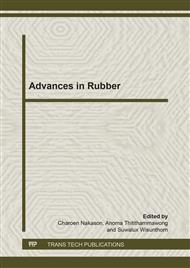p.322
p.326
p.330
p.334
p.338
p.345
p.349
p.353
p.357
The Influence of CB, Silica and CaCO3 on Tensile and Morphological Properties of vPE/rPE/EPDM Blends
Abstract:
The virgin polyethylene (vPE) and recycled polyethylene (rPE) was melt blended with ethylene propylene diene terpolymer (EPDM) in different ratio by using a Haake Rheomix at 180°C and 50 rpm were prepared. The characterization such as tensile properties and morphology were examined. Results indicated that, the tensile strength and youngs modulus of vPE/rPE/EPDM with CB show the highest value compared to silica and CaCO3 except for elongation at break. The scanning electron microscopy (SEM) studies proved that, better dispersion and less agglomeration of CB and silica filled particles as compared to the CaCO3.
Info:
Periodical:
Pages:
338-341
Citation:
Online since:
November 2013
Keywords:
Price:
Сopyright:
© 2014 Trans Tech Publications Ltd. All Rights Reserved
Share:
Citation:


